Bread Machine Yeast? Instant Yeast? Active Dry Yeast? What’s the Difference?
Last Updated on December 3, 2025 – Originally Published in March of 2017
Bread machine yeast. Rapid rise yeast. Active dry yeast. Instant yeast. Why are there so many types of yeast? Why does yeast have to be so complicated and confusing?
To be honest, much of what I’ve read about yeast is bewildering.
For example, The No-Fuss Bread Machine Cookbook, states that “The best bread yeast for bread machines is bread machine yeast or active dry yeast.” However, the recipes in the book involve bread machine yeast or instant yeast. Active dry yeast isn’t even mentioned and I never saw an explanation about instant yeast versus bread machine yeast.
My mother gave me her Welbilt bread machine. (Thanks, Mom!) The manual has recipes that can use active dry yeast, quick-rise yeast or bread machine yeast. That’s great, but the amount of active dry yeast in all the recipes is wrong.
If you’re like me, all you want to know is what type of yeast to use in your bread machine.
Here’s the Big Secret about Yeast
I didn’t catch onto this for a while, but once I did it confused me even more. Despite all the types of yeast sold in the grocery store and despite all the bread recipes calling for different types of yeast . . . there are really only two types of yeast.
Let me say that again, there are just two types of yeast. Those two types are instant yeast and active dry yeast.
Bread machine yeast and rapid rise yeast are just types of instant yeast. This means that bread machine yeast, rapid rise yeast and instant yeast can all be used interchangeably.
Also, if you know how to convert between the two main types of yeast (instant and active dry), then you can use either type of yeast in your recipes.
All of this was a little hard for me to take in, so I tested everything and found it to be true.
What Does Yeast Do?
Before we get into what type of yeast to use, let’s start with the basics. What does yeast do exactly?
Yeast makes bread rise.
Yeast is made up of small, single-celled organisms that eat simple sugars. That process gives off carbon dioxide and alcohol. The carbon dioxide that yeast produces is in the form of tiny bubbles that makes bread dough expand and stretch.
Active Dry Yeast
One type of yeast, probably the most common type, is active dry yeast.
Historically, active dry yeast needed “activated” by dissolving it in water before using it. They called this proofing.
However, changes in the manufacturing of active dry yeast enable active dry yeast to be in bread machines without proofing. Yes, you read that correctly.
Do not proof active dry yeast when using it in the bread machine.
Instant Yeast
Instant yeast came on the scene in 1973.
Instant yeast has smaller yeast granules than active dry yeast. It may also contain a dough conditioner (ascorbic acid) to help make the bread rise more quickly.
Bread machine yeast and rapid rise yeast are both types of instant yeast.
Yeast Tests
There are only two main types of yeast? Bread machine yeast, instant yeast and rapid rise yeast are all the same thing?
It was hard to take in so I decided to test.
I went wild and spent a few days making a dozen loaves of bread. Some loaves of bread were made with my beloved Zojirushi bread machine. Other loaves of bread were made with my Mom’s Welbilt machine.
It got a little insane. Not to worry though, I sliced and froze all of the bread. None of it went to waste.
Instant Yeast Test – Are Instant Yeast, Bread Machine Yeast and Rapid Rise Yeast Interchangeable?
To test the statement that instant yeast, bread machine yeast and rapid rise yeast are interchangeable, I made three loaves of sour milk bread.
All of the loaves were made with whole milk. (The milk wasn’t actually sour.) All of the loaves were made using the quick (rapid-rise) cycle of my bread machine. The only difference between the loaves of bread was the yeast.
I made these loaves of bread with (from left to right) bread machine yeast, SAF instant yeast and rapid rise yeast. As you can see, the loaves look the same.
Instant yeast, bread machine yeast and rapid rise yeast can be used interchangeably.
Formula for Substitute Instant Yeast for Active Dry Yeast and Vice Versa
Here’s another thing that I’ve learned. If you know how to convert the amounts of instant yeast to active dry yeast (and vice versa) you can use either type of yeast in any recipe.
For 1 teaspoon of active dry yeast use 3/4 teaspoon instant yeast
Important Facts:
Bread machine yeast and rapid rise yeast are both types of instant yeast.
1 package of yeast (all types) contains 2 1/4 teaspoons or 7 grams of yeast
Yeast Conversion Test One
The first test involved me using active dry yeast in the quick cycle of the bread machine.
Again, these loaves were all made using my sour milk bread recipe. All of the loaves were made with whole (not sour) milk. All of the loaves were made using the quick (rapid-rise) cycle of my bread machine. The only difference between the loaves of bread was the yeast.
Notice that there’s one more loaf now.
These loaves of bread were made with (from left to right) bread machine yeast, SAF instant yeast, rapid rise yeast and active dry yeast.
I used 3 teaspoons of yeast for all the yeast types except active dry. With active dry, I used the formula above and used 3 3/4 teaspoons yeast. (1 1/4 times 3 = 3 3/4) As you can see, the conversion worked.
Yeast Conversion Test Two
Test two compared active dry yeast versus rapid rise yeast in the basic cycle.
As I said earlier, my mother gave me her bread machine. It’s a Welbilt dual loaf machine that actually allows me to make two one-pound loaves of bread at once. It was perfect for this experiment.
I used this sandwich bread recipe for both loaves of bread. I used the basic cycle with the medium crust setting for both loaves.
However, the loaf on the left was made with 1 teaspoon of quick rise (instant) yeast. The loaf on the right was made with 1 1/4 teaspoon active dry yeast.
Again the conversion worked.
What Yeast to Use in the Bread Machine
In general, any of the types of yeast mentioned in this article are fine. I use active dry yeast except when I’m using the rapid-rise cycle. In that case, I use instant yeast.
Some bread machines, but not all, require that the liquid be heated to a certain temperature before being added to the bread pan. This is done to provide a yeast-friendly environment.
My Zo has a preheat cycle. So I just put the liquids in the bread pan and the machine takes care of heating everything up the correct temperature before it begins the first kneading cycle.
My Mom’s Welbilt doesn’t have a preheat cycle and doesn’t say to heat the liquid. So I didn’t and it worked fine. I just used warm tap water.
In terms of actually placing the ingredients in the pan, most bread machine manufacturers recommend that yeast be placed in a sort of nest in the bread machine pan.
Here’s a picture of how my bread machine pan looks when I’m making Banana Raisin Bread. See the yeast nestled in the flour?
How to Store Yeast
I buy active dry yeast at Costco. It comes in a large package that I transfer into two glass jars once I get home. I keep both of the glass jars in the refrigerator.
It’s the same with instant yeast. After opening the container, I store the yeast in the refrigerator.
I’ve heard of people keeping their yeast in the freezer. They say it works, but I’ve never tried it.
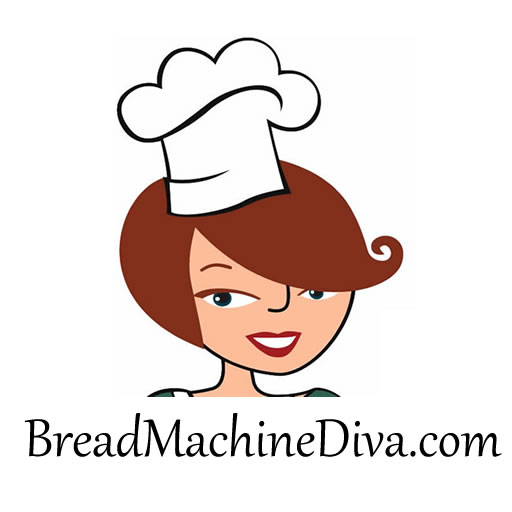

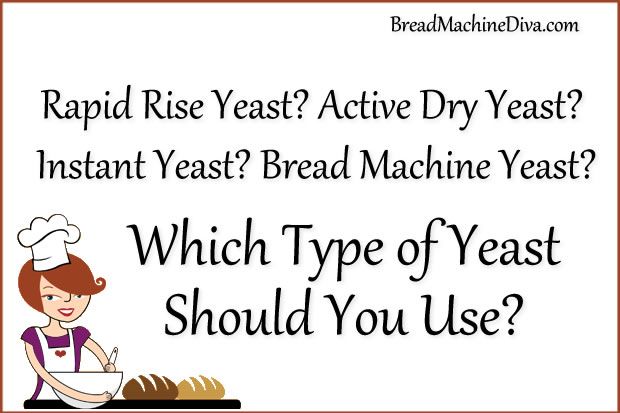
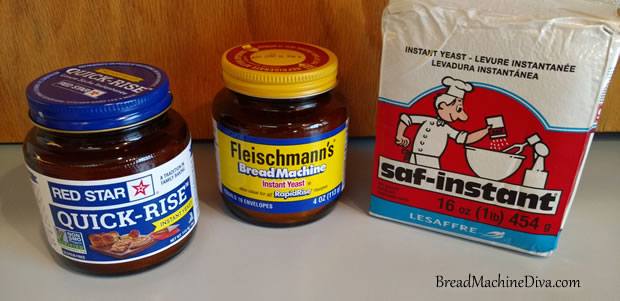
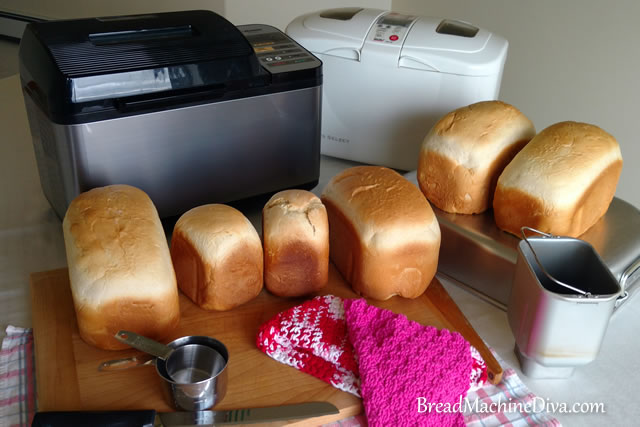
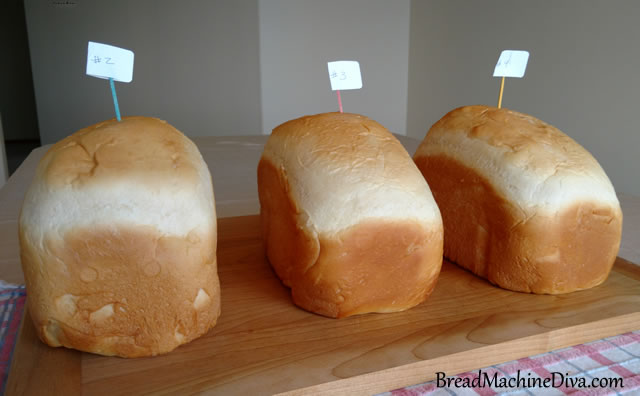
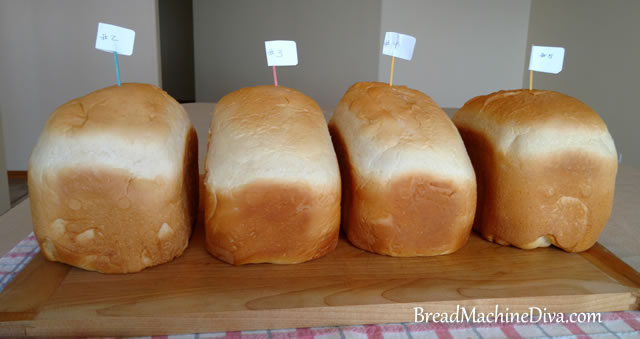
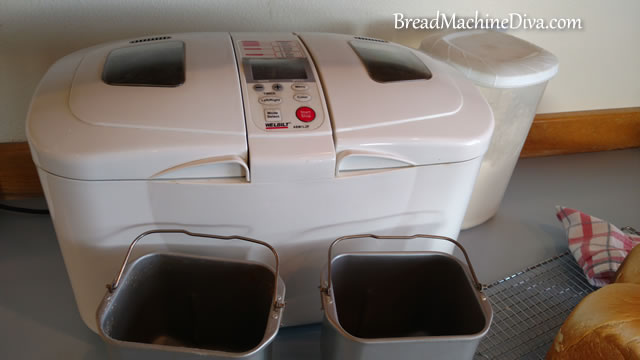
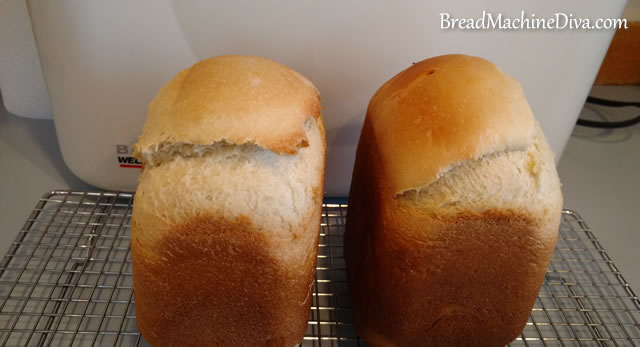
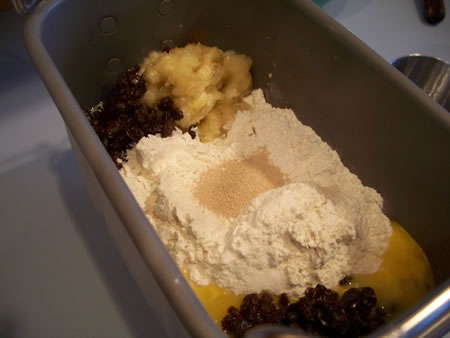

I buy my active dry yeast at Costco. I make about a loaf a week, so a Costco pack lasts a long time. I jar most into the freezer and a keep a 4 oz jar in the fridge. I put the yeast in a little crater on top of the flour. I’ve never tried any other yeast or method because it simply works.
I’ve had a Zojirushi BB-CEC20 since 2011 (I’m on my second one).
Arusha, I’m a brand new arrival here, and wanted to thank you for your site! I found you through a reference on The Wirecutter (NYT testing site). I’ve used a Toastmaster machine since our original Dak TurboBaker died decades back. Yesterday I lucked into a yard sale Zojirushi BBCC-V20 for $3 (I know!)… Not sure of its vintage, but it appears in fine shape. It’s just finished a loaf of your Sour Milk Bread as its first test, and it looks and smells amazing!
There IS a yeast question here… I’ve mostly used the Better Homes & Gardens books of Best Bread Machine Recipes, and their test kitchens recommend 1t. for 1 or 1 1/2 lb. Loaves and 1 1/4t. for 2 pounders. I’ll confess sometimes my 1 1/2 lb loaves were seriously under-raised, which I usually attributed to old yeast or cold ingredients. How do you think they got so far off the mark? Their recipe books were published in the mid-90’s.
I’m so glad you like the Sour Milk Bread recipe. It’s one of my favorites!
I think you and I have the same Better Homes & Gardens cookbook! My version treats active dry yeast and instant yeast interchangeably. They’re not the same thing. So I wonder if their recipes were really written for instant yeast.
I just wanted to stop by and thank you for publishing this post. I got my first bread machine today from Goodwill and felt lost as I read the manual. I had bought a year’s worth of active dry yeast and was taken aback when the manual mentioned bread machine yeast, which I had never heard of before. I used your conversion formula, and it turned out wonderfully. Thank you so much!
Can you provide a little input here? My Cuisinart bread machine manual and recipe booklet says “yeast, active dry, instant, or bread machine” and provides only one measurement in the recipes. How do I know which yeast is implied? I bought active dry.
You might try emailing Cuisinart and asking them. If you don’t get a response, I’d try a recipe using active dry yeast and see what happens. If the bread doesn’t rise enough the problem might be that the recipe intended you to use instant yeast. No worries though. This page has a conversion formula for that so you can still use your active dry yeast instead of instant yeast.
Hi there! Your website is amazing, I really appreciate all of the time and effort you put into this article and to doin some solid research! So glad I found this! I ended up here because I am having a few struggles making bread in my bread machine. I have the KitchenArm bread machine and made a 1.5 lb loaf of white bread as well as a 1.5 loaf of egg bread and both turned out excellent. Recently, I tried making a 1.5 lb of whole wheat as well as a 1.5 lb of dark rye bread and both collapsed while baking (i.e. they rise during the rising phase, but then when they bake there is either a hole down the middle or the top is hollow. I have used Fleischmann’s quick rise instant yeast for all four recipes and followed the book instructions each time. The white bread and egg bread were perfect, while the whole wheat and rye bread were complete failures. Any suggestions?
Do the recipes call for vital wheat gluten? If not, you may want to add that. Here’s an article on vital wheat gluten.
my Fleischmann’s yeast, in big letters, is “Quick-Rise”; in smaller letters, “Active Dry” – so confusing!
They make it hard, don’t they?
I cannot tell you how informative this is! I have never been taught anything about yeast or my bread machine and have felt like everything I’ve tried has about a 50% chance of flopping! Hoping to see some improvement after reading this!!
Thank you so much for the yeast explanation. Recently became a singly guy at age 77 and trying to learn how to make my own bread. My favorite bread became over $6 a loaf and I just can’t afford that. Bought a bread machine and trying to get the process down so I can make good bread. Thanks again…
Thanks so much for writing. Yes, buying good bread can be so expensive! Bread machines are the way to go!!
THX so much for the time invested in doing this research! It was very helpful. Just picked up a new machine this morning and will break it in this afternoon! I do enjoy using a bread machine for convenience in summer and fall. I seem to have more time to make bread in the winter since the garden is buttoned up for the season.
I do buy my yeast in larger quantities and vacuum seal it in my canning/jelly jars and freeze. Works great and extends the yeast life by about a year.
I’ve had very good luck buying Costco active dry yeast, freezing most of it, and then moving some to the fridge jar every so often.
Thank you Thank you for the great information. I will try it out. Solves lots of concerns
Thanks so much. I knew that it had to be ok to use active dry yeast in place of the others in a bread machine but I was just about to try using equal amounts as well as proofing the yeast. You saved me from what was probably going to be an epic fail. Thanks again.
I have been recently reading about something called “natural yeast”. Are you familiar with it? Can it be used in a bread machine? If so, how would I convert the measured ingredients to be successful with it? Thanks.
Great question! Natural yeast doesn’t really work in bread machines as the performance of the natural yeast can vary a lot in terms of potency and flavor.
Very helpful. I was about to make bread the old way as I had plenty of active dry but no bread machine yeast left without an inconvenient trip into town. Cheers from NZ.
I’m so glad I could help!
Marsha, First I want to thank you for your wonderful web site ! It is a terrific help to me and all BM users. Yesterday, I made your Peanut butter bread and followed the recipe, careful to keep each measure exact. I wondered about the 3 1/2 teaspoon of yeast but I forged ahead thinking it could be due to the heaviness of the peanut butter. The loaf was a huge lid bumper! I’am wondering if the yeast amount was a type O. I always use 1 3/4 teasp. active dry yeast that works well in Zo’s recipes. We live at a altitude of a little above 2900 feet. I have a Zojirushi -X20. Hope you can give me a clue as to what the problem is for the Peanut butter bread fail. Thank you, Gail Parker
Hi Gail, I haven’t made that one in a while. I’ll test it again just to make sure. However, a lot of people have tried it and it’s worked for them. Let me ask you, what sort of peanut butter did you use. I’m thinking that the recipe working out might depend on something like Jiff that has a lot of salt in it.
I too had a 2 lb Welbuilt bread machine. After 30 years of dutiful service, it finally laid down and died! But my son, taking pity on me (and wanting more home made bread of course!) bought for my birthday last year a bread machine made by Pohl Schmitt. Even though it claims to be a 2 lb machine, it really is a 1½ lb machine (I can barely make a 2 lb loaf if I cheat a little on the final rise time). I’ve used several different kinds of yeast and have found them all to work quite well. As a “yeast whisperer”, I also add yeast nutrient to each loaf to help the yeast out from going through the rehydration and gemmation stages during rise. Also, I didn’t see any mention of spring differences in your test loaves. Were their any differences in that regard? What about crumb, and textural differences? Just being curios, and always welcome your monthly emails and subsequent recipes! Keep up the great job that you are doing!
Thanks so much for your kind words! I only tested for rise in my yeast experiments. Maybe on the next round of tests I can add in some of your suggestions.
Very informative site. I will come back to it often.
Thanks for this great article. When you say that Bread Machine and Active Dry Yeast are INTERCHANGEABLE, do you mean that if a recipe calls for one, you can use the other, BUT you should do the conversion of amounts?
Second question – if that is the case, and the recipe calls for “yeast, active dry, instant or bread machine,” how do I know what amount to use – there is no conversion to use? But, it seems that it would be different amounts, depending on which type of yeast I use, right? So so confusing, no matter how many times I read about this! Thank you for considering my 2 questions!
Yeast is really confusing isn’t it? Yes, active dry and bread machine yeast (bread machine yeast is a form of instant yeast) ARE interchangable. Look for the section “Basic Yeast Conversions” for the formula for switching between the types of yeast.
Hi
I am a newbie to Breadmaking with only failures as my award. I just bought a Breadarm breadmaking machine that was being sold by my neighbor for $30. I am wondering if I should blame the machine or my skills for my failures. Could you help me with what I should do or what recipe to try. I tried 2 recipes from the bread machine book, 2 YouTube recipes. None of the breads have come out fluffy. So I am wondering if its time for me to give my machine away after all. I use the Kings Bread Flour and the Fleishman Active Yeast. Could you please point me to a recipe of yours that would re instore my confidence in making bread.
Thanks so much for writing! It’s hard to tell what the issue might be. Make sure that your flour and yeast are fresh. If they’re okay, maybe the recipes just aren’t right for you. I really like sour milk bread. Why don’t you give that one a try and see what you think.
Maybe you should write off the $30 and get a different machine? My first machine worked fine for years, then went into storage for a while. When I got it out and started making bread again, loaves came out dense and crumbly. I don’t know the reason, maybe some temperature sensor or time was not working properly, but anyway I tossed it and invested in a Zo (the 1lb mini because it’s just me eating the bread).
BTW, love the website
Thanks for the kind words about the website!
I am struggling with your tests, you state
Yeast Conversion Test One
All of the loaves were made with whole milk. (The milk wasn’t actually sour.) All of the loaves were made using the quick (rapid-rise) cycle of my bread machine. The only difference between the loaves of bread was the yeast.
Then picture of 3 loaves followed by the statement
These loaves of bread were made with (from left to right) rapid rise yeast, SAF instant yeast and rapid rise yeast. As you can see, the loaves look the same.
This states you used 2 types of yeast for the 3 loaves, I assume SAF instant yeast is the package show in first picture names SAF Instant Yeast. What is the other or is one the Red Star and the other is the Fleischmann’s Bread Machine ?
Very confusing as you state rapid rise yeast twice and we have no way to know what yeast you are talking about.
Thank you so much for leaving a comment!! I can’t believe that I missed that.
I went back to my notes and have now properly labeled the bread photos.
So If I read this correctly you use your active dry yeast without proofing it? And do you put it on top like in a little hole like you do with instant yeast? I used to do it that way in the past some of the Fred’s flopped and some didn’t.
Thank you
Right. No proofing needed. Just put the yeast in a “yeast nest” when loading the pan.
I have that same Zojirushi bread maker. The manual says the liquid should be 90 to 110 degrees I believe. The problem is that the active dry yeast says that when do you use it in a bread machine, the liquid should be 80°. I don’t know which is right.
I’ve never seen that in any of my Zojirushi manuals. And I’m a manual reader too. 🙂 What page is it on?
You have a slight mathematical mistake in the conversion formula:
Given that 1 teaspoon of instant yeast equals 1.25 teaspoons of active dry yeast, then the inverse, 1 teaspoon of active dry yeast, equals 0.8 (4/5) teaspoons of instant yeast, not 3/4 of a teaspoon.
This follows because when converting back, you use the reciprocal of the conversion factor: the factor from x to y is 1.25, so from y to x it is [1/1.25 = 0.8 = 4/5].
Thank you so much for the thoughtful explanation — you’re exactly right about the math. The precise reciprocal of 1.25 is 0.8, not 0.75.
In practice, though, that tiny difference (about 0.05 teaspoon) is too small to measure accurately in a home kitchen and won’t affect how a loaf rises. Most bread-baking guides round it to 3/4 teaspoon simply because it’s practical and easy for bakers to use.
Still, I really appreciate you pointing it out. It’s always great to hear from readers who care about both the baking and the details!
Love your website.
Thank you so much!!
I really liked your recipe for sour milk bread! However, I’m lazy sometimes, and have substituted buttermilk for the sour milk used in equal proportions. I’ve also used 2 tsps of Bella Gold instant yeast without a problem for all my baking needs. Now I’m using Saf-Instant yeast (also gold)as Bella wasn’t available at the time and it was priced right at $4.91 a pound! Tomorrow, I’m making dinner rolls that resemble Rhodes dinner rolls in flavor, aroma, crumb, and texture. Of course buttermilk will be used in this recipe as well. Cheers!
What happens when you use rapid/instant yeast with the regular bread setting, not the rapid cycle? I’ve use rapid/bread machine yeast, and I do not remember using the rapid cycle.
Check out “Yeast Conversion Test Two”. You can use rapid rise yeast in the basic cycle.
Thank you Marsha.
I should try the rapid setting on mine. It would save a bunch of time, and I can eat sooner 🙂
LOL! 🙂
Hi, I have a question. If I use active dry yeast in bread machine, do I still put the water that is supposed for proofing the yeast if I can put the active dry yeast without proofing it? Thanks! Because my recipe calls for another cup of water for the dough and another cup of water for the yeast proofing.
If I understand you correctly, the answer is yes you’ll still need that water. You can also look at other bread machine recipes to see if the amount of water seems normal.
I have just found your site and found it very interesting as have been finding it very difficult to find yeast (live in UK). I’ve used a bread maker for over 20years and always used instant yeast, even on the delayed program. As I was only able to get fresh yeast I tried this in my machine, just popped it in first before the flour and 5 hours later a lovely wholemeal/white flour loaf. It seems that most yeast will work, some slightly better than others. Thanks for your help.
I’ve run out of bread machine yeast which I’ve always used with my bread machine successfully. I have plenty of active dry yeast though so I’ll use that. My question is if I proof it with some of the liquid ingredients in the recipe is it poured into the machine first along with the other liquid ingredients or is it poured over the top of all The dry ingredients which is the standard procedure with my machine. My machine is a black and decker all-in-one. Thanks
I’d suggest trying the active dry yeast without proofing it. That’s what I do and it works fine.
When I proofed the yeast, I put the proofed yeast + water/liquid in at the beginning, with the other liquid. Seems to work.
But if you can get it to work without proofing, as Marsha does, I would go that way. It is just simpler.
I ordered yeast from Costco and expected to get a 32oz jar of granulated yeast. Instead I received a 2 lb solid block of yeast. I am not sure how to proceed with it!!!! Do I grate it or do I have to guess the exact weight of what I need and cut it off….I am so confused!!!
I get yeast at Costco. While it looks like a big block, it’s just really just tightly packed. We put ours into 2 glass jars and store them in the refrigerator.
I attempted my first loaf today of wheat bread. It rose, it fell, it has a face only a mother can love. However, it tastes fine. Due to the pandemic, I was only able to find active dry yeast, and not bread machine yeast. I did not proof it, and I’m thinking that was literally the downfall. My question is, the next time I attempt it, if the yeast calls for 1/4 cup of liquid to dissolve it, do I then decrease the other water I add? For example, if the recipe calls for 1/2 cup of water, then do I decrease it to 1/4 cup because that’s getting put in with the yeast? Thanks!
LOL. I’ve had bread that looks like that too.
I’m just not sure about your yeast question. With my bread machine, I use active dry yeast and don’t proof it.
If you do proof the yeast, your idea about decreasing the liquids sounds right.
That is what I do.
TOTAL water is per instructions, 1/2 cup.
You are just using 1/4 cup of that for proofing, which will go into the bread machine with the proofed yeast.
A little hint I learned from my mother-in-law. Before making cinnamon raisin bread, take out the raisins the night before, put on a small plate and freeze them. Add the frozen raisins when you mix all the ingredients. They stay solid during the kneading, then thaw for the baking cycle. It’s a lot better than cinnamon SMASHED raisin bread.
Great tip! I’ll have to give that a try.
Hi, I have a Regal bread maker. All the recipes call for active dry yeast. But i can only find Rapid Rise instant yeast during this pandemic. There is a setting on the machine that says “Bread Rapid” but the manual just says it shortens the time by 50 min. It doesnt say anything about using a different yeast for that setting. Is there any way to adapt??? Thank you.
Try using about 25% less yeast if you’re substituting rapid rise yeast for active dry yeast.
I have been using a Black and Decker bread maker machine and the manual says “if you prefer to use Traditional Dry yeast, Rapid Rise yeast or Quick Rise yeast, you will have to increase yeast by 1/4 teaspoon per teaspoon …for example – if your recipe called for 1 teaspoon of yeast, increase the amount to 1 1/4 teaspoons.
Working backwards from this, bread maker machine yeast could be used in a recipe not using a bread machine by reducing the amount of yeast by 25 percent.
Reduce by 20% not 25%.
Because if you increase by a quarter, you end up with 5 lots not 4 so you need to reduce by 1/5 or 20%
Hi there! I am new to your site and I am so excited to start making your recipes! With that being said, I could use some advise. The only yeast I could find right now due to the corona virus is bread machine yeast. Do I use the same amounts of this type of yeast even when your recipe calls for active dry yeast or rapid rise yeast? I see so many amazing recipes I want to try, but I’m afraid my yeast won’t work. Thank you for your help! Stay safe!
Great question! In my recipes, you can use active dry yeast and bread machine yeast interchangeably. Rapid rise yeast is a different type of yeast.
Thank you so very much! I was hoping that was the case. My new bread machine will be here tomorrow and I can’t wait to start making recipes. My two oldest are home from college due to the virus so between the five of us we have been eating so much! Haha. The freshly baked bread is going to be a hit! Y’all stay safe.
I have a jar of Fleischmann’s Bread Machine Yeast. The label states that it’s Instant Yeast and also ideal for rapid rise recipes. So, in this case, their bread machine yeast & active dry yeast ISN’T interchangeable? So confusing.
Lori, I just redid this article. Take another look and hopefully, this new information clears things up.
Hello there, I have two jars of Fleishman’s bread machine yeast that we bought by mistake last summer. Since we don’t have a bread machine, it’s sat unused until now, when we would really like to try and make some bread! I am wondering what adjustments I need to make when making traditional bread recipes with this type of yeast? I tried following what I thought was a simple bread recipe and it came out quite dense and heavy. It did end up making good croutons, though! I’m a seasoned cook and baker, but bread and yeasted dough is something I rarely do! I’m hoping to make rustic loaves or pan style sandwich bread to start. Any advice? Thank you!
I’ve only made bread without my machine a handful of times. So my advice on this subject is limited. That being said, why don’t you pick out one of the recipes on the site and start with that? You might like the sour milk rye bread recipe.
I have been making gluten free bread in my maker for 8 years with brown rice flour. Due to my he present crisis with panic buying I cannot find any dried yeast anywhere, I have managed to get some fresh yeast from the bakery counter at the supermarket but they did not know the procedure to use it in the bread maker i.e if it needs proofing and how much to use. I normally use 2 tea spoons at the last minute. Any advice would be appreciated. Thanks
I’m sorry, but I’m not sure how to advise you.
I found lots of yeast in my local convenience store in their small baked good section
Hi! I just subscribed and am going to attempt to make basic sour bread recipe you have on your website with an old zojirushi BBCC-V20. I bought the red star active dry yeast at Costco and I bought a huge bag of ardent mills harvest bread flour at Costco. I have limited fridge and freezer space because of the coronavirus. How can I best store the flour to make it last as long as possible once I open the bread flour bag? Thanks so much!
I have two food-grade buckets for storing flour. Any food-grade container with a tight sealing lid should work.
Then store the flour container in a cool, dry place away from sunlight.
I’ve heard that it’s best to first put the flour in the freezer for 48 hours first. That will kill any weevil or insect eggs in the flour. However, we haven’t done that because our bags of flour are so large.
Hi. Stubbled onto your site & am very happy that I did. Made the egg bread today & it turned out perfect. I live at 5000 ft & finding recipes that allow for that are few & far between. Now I want to make a loaf of rye bread. Hope you have a recipe! Oh, ya; bought my bread machine at a thrift store. No instruction booklet.
Welcome to my website! 🙂 You are so in the right place! I’ve got a bunch of rye bread recipes for you to look at. Here’s an article about using your bread machine at higher altitudes. And with any luck, you’ll find a manual for your machine on this page.
I also just bought a Zojirushi Virtuoso Plus (BB-PDC20) breadmaker. As Scott said, the manufacturer’s recipe book recommends the use of Rapid Rise yeast in every single one of their bread recipes (and not just for their ‘rapid’ bread recipes) in the colour booklet that came with the Zo bread machine, except for the sourdough recipe (which recommends active dry yeast be used). But a number of other sources highly recommend instant yeast be used in bread machines. So I am confused! I welcome guidance on this matter.
I’ve downloaded a copy of the manual. I’m not sure why they’re recommending rapid rise yeast for everything. Here’s what I’d do . . . I’d make two loaves of bread using the same recipe. In one loaf use active dry yeast and in the other use rapid rise yeast. See which works better for you and then use that going forward.
Instant dry yeast is a lot like rapid rise yeast. You can do a third test if you want using that.
Why is it so complicated? I don’t know. But there are subtle differences between different models of Zojirushi bread machines. So if the manual says that rapid rise yeast is best, I’d at least experiment with that.
I’m a newbie at bread machining and just got a Zojirushi virtuoso plus. It says to use rapid rise yeast in its bread courses. Can I use the active yeast instead? Would I have to alter the timing?
Scott, I’m a big believer in following the instructions in the manual, but that sounds odd to me too. Are you sure it doesn’t say to use rapid rise yeast just when you’re using the quick setting?
I have a Zo and I use active dry yeast most of the time. I only use rapid rise yeast with the quick or rapid cycle.
Scott, I’ve investigated some more and confirmed that the manual says to use rapid rise yeast.
I’m not sure what that’s all about. If it were me, I’d make two loaves of bread using the same recipe. In one of them, I’d use the active dry yeast. In the other, I’d use rapid rise yeast and see what happens.
I use instant dry yeast in the bread machine,and my bread rises well. However, there is a lingering yeast smell that spoils the warm smell freshly made bread. Is this common?
The fresh breads we buy don’t have that smell.
Interesting! I haven’t heard of this issue before.
I’m from England UK and I’m confused about which yeast to buy for my bread maker. There seems to be so many different types / packets
I looked at the yeast available to the folks in the UK and I see why you’re confused. Yikes! I thought it was confusing in the US!!
Judging by this article from the BBC I’d recommend “powdered (or ‘easy-blend’ or ‘fast-action’) dried yeast which is sold in sachets and just sprinkled straight into a bowl of flour.” That’s the equivalent of the “active dry yeast” that I recommend for use in the United States.
Every time I make bread in my machine it sinks in at the top & it isn’t as light as I wish that it would be & it is crumbly. What do I need to do to fix it.
Check out this article on bread that has “the big valley”.
Technically, there is no such thing as “bread machine yeast.” Yeast is classified by how it works, not where it works. SAF works better everywhere than the other brands. Here’s the proof:
https://blog.kingarthurflour.com/2016/01/29/yeast-use/
I use SAF Instant Yeast- Red Package. I have used it for over a decade, both in the bread machine and mixer made dough. It stores well in the freezer. I have used it way past date.
I see SAF Instant Yeast has a Gold Package now. It is pricier. I read the “Gold” version is just a more resilient strain of yeast. It survives better and will make your dough rise in harsher recipes like extra sweet or gluten-free.
Help ive used my bread machine with active dry yeast without any problems. Ive purchased instant yeast by mistake and it did not work. Im hoping i can use it i purchased a large bag of it. Any help woukd be appreciated.
Debbie
That’s weird as it should work just fine. Check the date and make sure it’s not old. Also, are you proofing it? If so, I would try not proofing the yeast.